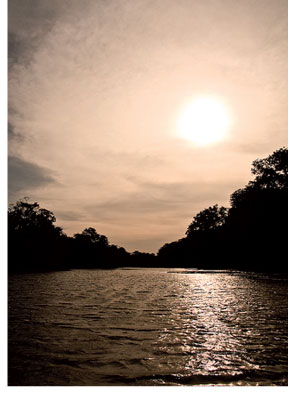
Night Safari near Kumana
It might raise a few eyebrows
but with a band of exciting journalists and guest of honour Lalith, one
of the best experiences of travelling to the East was doing a midnight
safari very close to the Kumana National Park and Sanctuary.
 Enthralled by the deep and dark mysterious forest where we didn’t
tread beyond the dirt track, we managed to see a lone elephant with its
shadow falling on to the grass in the moonlight, some wild boar in the
distance and white rabbits scampering away! Enthralled by the deep and dark mysterious forest where we didn’t
tread beyond the dirt track, we managed to see a lone elephant with its
shadow falling on to the grass in the moonlight, some wild boar in the
distance and white rabbits scampering away!
It was truly a memorable experience where we braved the suspecting
officials and managed to do a good run of the night where we even
managed to stop at a small tea shop on the fringes of the Kumana
boundary.
The Kumana National Park and Bird Sanctuary is renowned for the
wonderful wealth of birdlife, especially its large flocks of migratory
waterfowl and wading birds. The park is 391 kilometres (243 miles)
southeast of Colombo, on Sri Lanka’s southeastern coast. Kumana is
linked with the Yala National Park which was formerly known as Yala East
National Park, but changed to its present name in September 2006.
Unfortunately, the park was closed from 1985 to March 2003 because of
the trouble period. Subsequently, it was affected by the Boxing Day
tsunami in 2004 but no animals’ fatalities have ever occurred.
The Kumbukkan Oya forms the southern boundary of the national park
and about 20 lagoons and tanks support the extensive birdlife of the
national park. The lagoons are shallow with depths less than 2 metres
(6.6 ft).
The Kumana villu is subject to occasional inundation with seawater.
The park’s wetland areas are surrounded by dry zone tropical thorn
forest. The inland forest’s flora is dominated by Manilkara hexandra
(Sinhalese “Palu”), Hemicyclea sepieria, Bauhinia racemosa, Cassia
fistula (“Ehela”), Chloroxylon swietenia (“Burutha”), and Salvadora
persica species.
The Kumana Bird Sanctuary is one of the most important bird nesting
and breeding grounds in Sri Lanka as it records a stupendous 255 species
of birds. During the April–July season, thousands of birds migrate to
the Kumana swamp area annually. On such an occasion, bird watchers can
spot rare species such as the Black-necked Stork, Lesser Adjutant,
Eurasian Spoonbill, and Great Thick-knee are breeding inhabitants of the
Kumana villu.
Waders belonging to families Scolopacidae and Charadriidae are among
the visitors to the area along with waterfowl. Pintail Snipes migrate
here flying 9,000 kilometres (5,600 mi) to 11,000 kilometres (6,800 mi)
from Siberia. The Asian Openbill, Glossy Ibis, Purple Heron, Great
Egret, Indian Pond Heron, Black-crowned Night Heron, Intermediate Egret,
Little Egret, Spot-billed Pelican, Indian Cormorant, Little Cormorant,
Common Moorhen, Watercock, Purple Swamphen, White-breasted Waterhen,
Pheasant-tailed Jacana, Black-winged Stilt, Lesser Whistling Duck and
Little Grebe are other bird species that migrate here in large flocks.
Among the rare birds that migrate to the swap include Yellow-footed
Green Pigeon, Greater Racket-tailed Drongo, Malabar Trogon, Red-faced
Malkoha, and Sirkeer Malkoha. Pacific Golden Plover, Greater Sand
Plover, Lesser Sand Plover, Grey Plover, Ruddy Turnstone, Little Ringed
Plover, Wood Sandpiper, Marsh Sandpiper, Common Redshank, Common
Sandpiper, Curlew Sandpiper, Little Stint, Common Snipe, and Pintail
Snipe are the common wading birds of the park. Tilapia and Mullet are
the commonly fished varieties in the area while Channa spp. are also
caught occasionally. Mugger Crocodile, Indian Flap-shelled Turtle and
Indian Black Turtle are the common reptiles inhabiting the park. Mammals
such as Golden Jackal, Wild Boar, Sri Lankan Elephant, European Otter,
and Fishing Cat also visit the swamp to feed.
 The number of elephants roaming in the Kumana is estimated at 30–40.
The Kumana area is part of an ancient civilization that goes back to the
3rd century BC. Anicent rock inscriptions from the 2nd and 1st centuries
BC have also been excavated in the area. The Kumana National Park lies
enroute of the traditional annual foot pilgrimage to the temple at
Kataragama. Both Tamil and Sinhalese communities take part in this
pilgrimage. We were not privileged to see these pilgrims but heard that
they spend the night in the park for a rest and bathe in the water tanks
around the park. The number of elephants roaming in the Kumana is estimated at 30–40.
The Kumana area is part of an ancient civilization that goes back to the
3rd century BC. Anicent rock inscriptions from the 2nd and 1st centuries
BC have also been excavated in the area. The Kumana National Park lies
enroute of the traditional annual foot pilgrimage to the temple at
Kataragama. Both Tamil and Sinhalese communities take part in this
pilgrimage. We were not privileged to see these pilgrims but heard that
they spend the night in the park for a rest and bathe in the water tanks
around the park.
Sadly, the number of birds have declined over the past few years.
Environmentalists and wildlife experts have expressed concern over a
road planned to be constructed from Kirinda to Panama which will run
along the coastline of the park but after the war, several developments
have made this area accessible and safe for visitors. However, it is up
to the people to really protect the area without damaging the wildlife
and nature because Kumana National Park and Sanctuary is the Eastern
blessing! |

